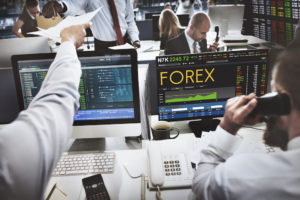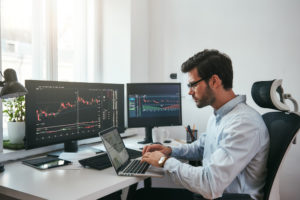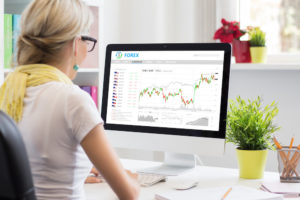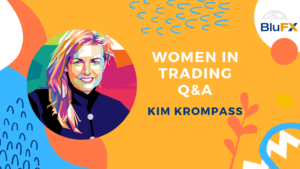Beginners Guide To Forex Trading

Having a beginner’s guide to Forex trading can be a fantastic resource for understanding the fundamental concepts of the foreign exchange market.
If you’re curious about how you can exchange one currency for another and see potential profits, this guide is for you.
Let’s explore some of the basic concepts of Forex trading to help you get started.
Is Forex Trading Good for Beginners?
Forex trading can be great for beginners thanks to the liquidity of the foreign exchange market and minimal startup costs.
As long as you can work with a reputable brokerage, you can make small deposits of as little as $50 to get started.
Another benefit that makes this market ideal for beginners is that it’s highly accessible, and open 24 hours a day, five days a week.
The lengthy hours make it far more appealing than the stock market, which is only available between 9:30 AM and 4:00 PM.
You’ll find more foreign entities participate in the foreign exchange market due to their extended offers.
There are a few other reasons why Forex is recommended for beginners.
Simplified Tax Rules
When discussing the governance of trading, it’s important to consider tax rules and regulations.
The Forex is known to have simple tax rules, making it easier and less intimidating for people to participate in.
Also, the regulations can prove beneficial; for example, minimal deposits are required to get started with few restrictions.
Customizable
The foreign exchange market is a fast-paced environment that can change at any time within minutes.
With that said, there are plenty of digital tools that you can use through your brokerage to customize your portfolio.
One of the most amazing tools for beginners is stop-loss as well as exit prices.
With these customizable features, you can program your account to start or stop trading based on losses automatically.
You can also determine when to sell to prevent your portfolio from incurring significant losses overnight.
Instead of continually monitoring your investments, as you would with some stocks, this process is more convenient.
Continual Access
One of the most significant downfalls of the stock market is that it’s based on a centralized marketplace.
On the other hand, Forex isn’t centralized, meaning you can trade at any time as long as the markets are open.
This trait is also why it’s a popular avenue for foreign investors.
They can work with their portfolios 24 hours a day.
Is Forex Trading Easy To Learn?
It’s important to remember that all types of trading require experience and learning at every corner.
This point is particularly valid with the foreign exchange market due to its fast-paced nature.
You’ll find that you’ll need to put far more time and effort into learning how to manage your money in this avenue effectively.
With that said, it doesn’t mean that Forex has to be challenging, especially if you want to make serious investments.
There are tools and individuals available to help make learning the foreign exchange market more straightforward.
Forex Mentors
There’s no better way to learn about something than to work with seasoned professionals who have real-world experience.
Forex mentors are an invaluable resource that every beginner should consider having in their corner.
These professionals look at your current strategies and change critical factors to help them become more successful.
The best Forex mentors will also give you tested methods to help improve your knowledge and skills over time.
Apart from teaching you the FX trades basics, a mentor can guide you through your investment journey while instilling confidence.
Forex Trading Classes
Another great way to get yourself to learn how to trade Forex successfully is to consider trading classes.
These classes are uniquely designed to focus on Forex trading for beginners in an easily digestible manner.
Resources like the Price Action Traders Institute course, Command Your Trading are fabulous examples, as they’re designed for the beginning trader.
On these platforms, you’ll find key tips to help you become a more successful trader.
You’ll also be introduced to a large community of investment professionals, all looking to achieve the same goals.
Whether you’re an experienced trader or just starting, online courses are a great option.
You’ll be able to work at your own pace, have one-on-one advice from potential mentors, and more.
Also, they’re continually updated with the most recent trading techniques to help you create your strategies.
Free Resources
If you’re not in a position to pay to learn how to get started with Forex, we recommend free resources.
You can typically find an assortment of beginner-friendly eBooks filled with essential information to begin trading.
It’s also possible to find free webinars, community forums, and other social avenues to network and meet other like-minded professionals.
Although free trading resources won’t be as in-depth as mentoring or paid classes, they can help you start.
How To Trade Forex for Beginners
The process of getting started to learn how to trade Forex for beginners is simpler than you’d think.
In fact, with the help of a professional brokerage, you should be able to get started in a matter of minutes.
Let’s review all of the critical steps to follow so you can begin diversifying your trading experience.
Step #1: Choose a Forex Broker
Before you get started, it’s important to know where to go to begin your journey.
Forex brokerages are where you’re going to want to set your sights, as they set you up to trade.
Fortunately, there are a vast number of brokerages that you can find online.
Using a complimentary service from our Forex broker support team can help ease the stress of finding the right one for you.
Where Do I Start Forex Trading?
Did you know that you need a Forex broker to begin trading in the foreign exchange market?
There are hundreds of brokerages worldwide that you can work with, depending on where you live.
However, not every group is made the same, and many aren’t certified by regulatory agencies.
When you begin the search for a Forex broker, you need to keep the following things in mind:
- Certification
All of the reputable brokers worldwide will be certified by a regulatory agency.
In the United States, the most common agency is the Commodity Futures Trading Commission (CFTC).
You should be able to see they’re a Futures Commission Merchant on the Financial Industry Regulatory Authority’s website.
- Tools and Resources
You must have access to several convenient, user-friendly tools when you choose a brokerage.
The truth is that many Forex brokers will have different trading platforms, all with their benefits.
Ideally, you’ll want a trading platform that offers:
-
- Real-time news and data
- Real-time charts
- Technical analysis tools
- Trading system support
- Economic calendars
- Fundamental research information
- Leverage Options
When trading on the foreign exchange market, leverage is necessary because of how low price deviations are.
Leverage is expressed as a ratio showing actual capital versus total capital available.
It’s the value that a broker will lend you so that you can begin trading.
For example, a 50:1 ratio means that you’ll be given $50 for every dollar of capital.
Depending on the brokerage you choose, you’ll find different leverage options, some as high as $250 per dollar.
Opting for lower leverage can be preferable, as there’s lower margin call risk, but it can also mean lower returns.
Step #2: Find a Forex Strategy
Once you’ve signed with a brokerage, your next step is to find an investment strategy that works for you.
The vast majority of successful traders will have a strategy that they refine over time until it’s near perfection.
You might find some strategies allow for spectrum analysis while others focus on a specific calculation.
It can be beneficial, to begin with, technical and fundamental analysis to make your trades as a beginner.
You’ll find this process helps you make long-term projections while also determining your exit points.
That said, every trader has strategies that work best for them.
Step #3: Start a Demo Account
Jumping into the Forex market right away can cause you to lose a lot of money in a short period.
A better alternative to get started is to try out a demo account or a paper trade.
This process allows you to learn the ins and outs of your trading platform before committing capital.
Step #4: Get Started
Once you feel like you’re comfortable enough to begin trading, you can get started with the help of your brokerage.
It’s important to remember that you’ll want to trade without emotion and focus on trends.
Trends happen for a reason and signify the Forex market is moving in a specific direction.
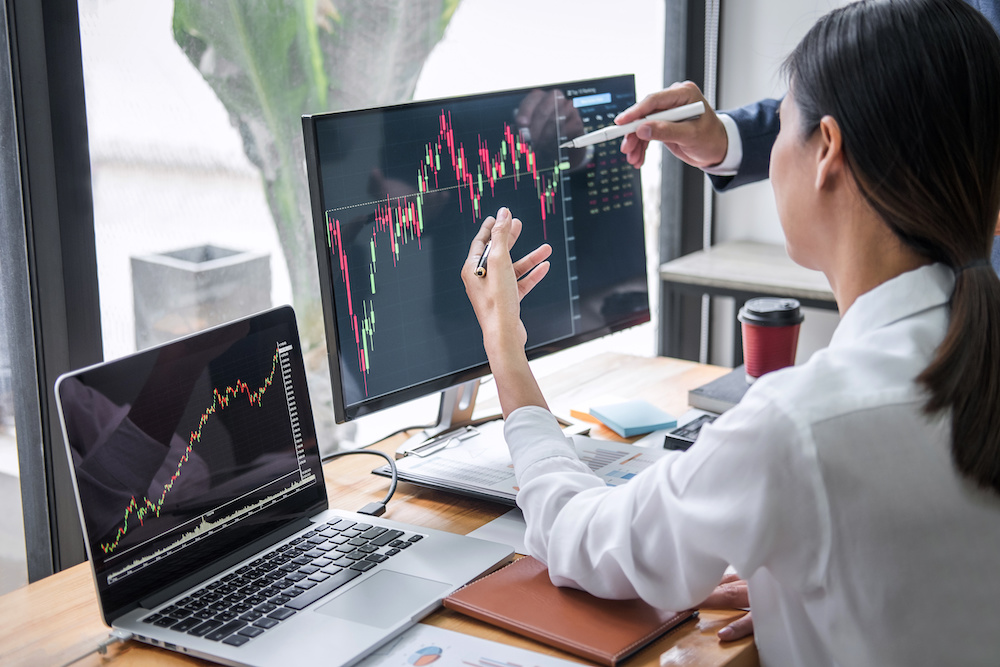
Other Beginner-Friendly Tips
Whether you’re researching the basics of Forex trading or if you’ve already started, there’s more information to gather.
We’ve collected various vital tips and questions to help you better learn how to trade Forex successfully.
How To Read and Understand Forex Quotes
Forex quotes are the most important plots of data you’re going to want to consider while trading.
They’re the price of one currency when compared to another currency, also known as pairs.
They’re important because you’ll need to know how much the currencies cost as you’re buying one and selling another.
For example, the Forex quote for one Euro could be $1.2103 when looking at a EUR/USD pair.
The majority of brokerages will provide two quote prices per pair and get the difference (spread) between both.
Reading and Understanding Forex Quotes
One of the basics of Forex trading is to know how to read Forex quotes.
There are several components that you’re likely to see, which can be overwhelming at first.
The most important basics to know include:
- ISO Code
This code is applied to global currencies, meaning the money is abbreviated to three letters (US dollar = USD).
- Base and Variable Currency
You’ll see two currencies on a Forex quote, one of which is the base (first listed) and the variable (last listed).
The price of the first listed currency is always shown in the same unit as the last listed currency.
For example, in the EUR/USD pair, the EUR is the base currency, and USD is the variable currency.
- Bid and Ask
The two prices you’ll find on your Forex quote will relate to the bid and ask prices.
The bid is always referred to as the selling price or how much the traders sell the currency.
While the asking price is how much traders can purchase a currency for.
You’ll always want to try to buy foreign currency when the price is low and sell it at a higher price.
Many traders will also sell when trends show that the currency is depreciating.
- Spreads
In most cases, the amount it costs to purchase currency will be more than its selling price.
The difference between these two values is known as the spread, and it’s how brokerages make money.
You’ll find most major currencies, like EUR and USD, have tighter spreads due to liquidity.
What Drives the Forex Exchange Rate?
A key to learning Forex trading for beginners is to know what influences exchange rates.
When working with foreign currency, there are a vast number of situations that can cause fluctuations.
Some of the most common include:
- Supply and demand
- Economic and geopolitical announcements
- Interest rate changes
- Inflation reports
- GDP numbers
- Manufacturing data
- Commodities
- Unemployment rates
There are also two different exchange rates to consider with the foreign exchange market: floating and fixed.
Floating exchange rates are determined by supply and demand.
If there’s a high demand for currency, the price is higher.
The vast majority of currency trading is based on floating rates affected by ongoing world events and trading activity.
Can Forex Trading Be a Full-Time Job?
When you’re learning how to get started with Forex, it’s improbable it’ll be profitable enough to be a full-time job.
Once you grasp the FX trades basics, you can invest more time and money into the project.
The foreign exchange market moves quickly, and many traders benefit from split-second decisions and moves.
Alternatively, you can save your time and effort by using digital tools to learn Forex trading basics.
Depending on your personal preference, you might enjoy having a more hands-on approach to trading.
Otherwise, you can have your investments generating income on the side while maintaining a regular full-time job.
Beginners Guide To Forex Trading: Final Thoughts
Using a beginner’s guide to Forex trading to learn the basics is a valuable way to get started.
With the help of a brokerage, you can test your hands at trading with a demo account before investing capital.
As your skills begin to diversify, you’ll find that managing your investments can become more straightforward.

